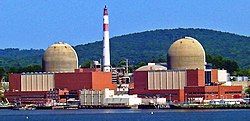 According to Biff Bradley, the director of risk assessment for the Nuclear Energy Institute, it's almost impossible to try to rank the absolute safety risk of a plant, due to the number of variables that would be involved in any sort of direct comparison.
According to Biff Bradley, the director of risk assessment for the Nuclear Energy Institute, it's almost impossible to try to rank the absolute safety risk of a plant, due to the number of variables that would be involved in any sort of direct comparison.
But given that some fundamental risks are obvious and plant safety records are public, relative risks can be measured. For instance, nearly half of the 104 nuclear reactors operating in the United States are close to major fault lines, including the Diablo Canyon and San Onofre plants located near California's San Andreas Fault. The Indian Point nuclear power plant in New York is less than two miles from the Pampano fault line, and sits within 50 miles of more than 17 million people.
Based on the input of more than a half-dozen experts in nuclear energy, nuclear engineering and risk assessment, The Daily Beast ranked the country's power plant sites based on three, equally weighted metrics: risk of natural disaster, safety performance assessments, and surrounding population.
In other words, which nuclear power plants are located in the most dangerous physical locations, have the weakest relative operating conditions, and would affect the greatest number of people should an unforeseeable emergency occur?





 Two fossil-fuel billionaires with close ties to Donald Trump bought millions of shares in the company...
Two fossil-fuel billionaires with close ties to Donald Trump bought millions of shares in the company... The Trump administration on Thursday announced new oil and gas drilling off California’s and Florida’s coasts,...
The Trump administration on Thursday announced new oil and gas drilling off California’s and Florida’s coasts,... International Atomic Energy Agency (IAEA) Director General Rafael Grossi said on Friday that an IAEA team...
International Atomic Energy Agency (IAEA) Director General Rafael Grossi said on Friday that an IAEA team... There are now three remaining deceased hostages in Gaza, following Thursday's return of the body of...
There are now three remaining deceased hostages in Gaza, following Thursday's return of the body of...






























